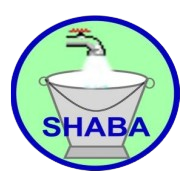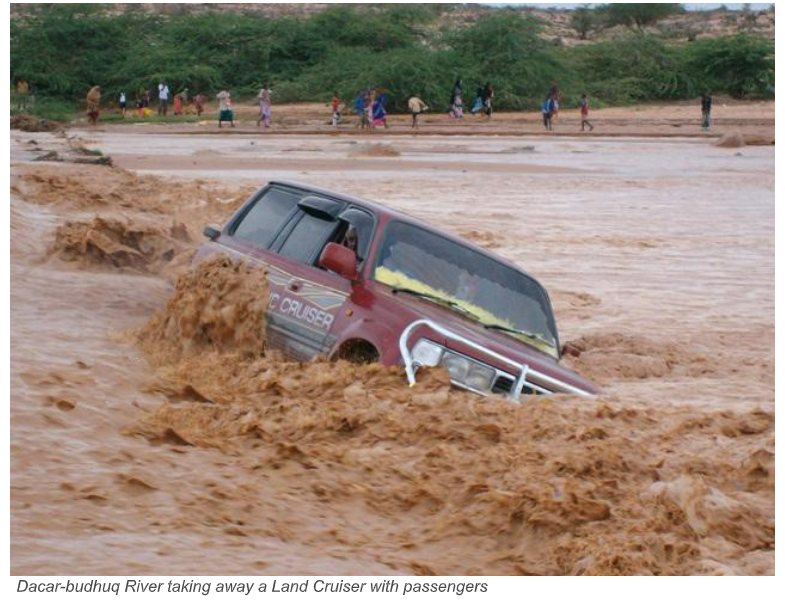By: Abdirahman Farah Omar, Abdirahman Abdisalam Sh. Ali, Khadar Ali Hassan
Ministry of Water Resources
June 2015
The document provides an in-depth exploration of strategies to enhance the management and utilization of seasonal rivers in Somaliland. Its primary aim is to address water scarcity issues by advocating for better exploitation of runoff water, which currently drains into the sea, causing significant wastage and land degradation. This challenge is critical for the country, as water is essential for domestic, agricultural, and livestock purposes, which form the backbone of Somaliland’s economy and livelihoods.
Purpose
The primary goal of the paper is to attract the attention of stakeholders in the Water, Sanitation, and Hygiene (WASH) sector, including government ministries, international organizations, and local NGOs, to the potential benefits of runoff water management. It calls for the establishment of a Somaliland Rainwater Harvesting Association, emphasizing the need for sustainable water resource development to improve food security and reduce poverty.
Challenges Facing Somaliland
Water Scarcity
Somaliland is characterized by arid and semi-arid climatic conditions, with annual rainfall averaging 350 mm. However, geographical disparities result in areas receiving less than 100 mm of rainfall annually, particularly in the coastal regions. High evaporation rates and environmental degradation exacerbate water scarcity. Over-reliance on seasonal rainfall and the absence of proper water storage infrastructure lead to severe shortages during the prolonged dry seasons.
This scarcity has far-reaching implications, affecting agriculture, livestock, and domestic water supply. Women and children, traditionally responsible for fetching water, are disproportionately impacted, with women traveling long distances and children missing out on education. Such challenges hinder progress towards universal primary education and gender equality.
Droughts and Environmental Degradation
Frequent and prolonged droughts have devastated Somaliland over the past two decades. These droughts lead to water shortages for both humans and livestock, forcing many nomadic communities to migrate or purchase expensive water at unsustainable costs. Simultaneously, environmental degradation, such as deforestation for charcoal production and soil erosion, contributes to reduced agricultural productivity and worsened hydrological cycles.
Water-Borne Diseases and Conflicts
Unprotected water sources like dams and barkads often become polluted with organic matter, leading to outbreaks of water-borne diseases. Vulnerable groups, including children and the elderly, are particularly affected. Water scarcity also fuels conflicts between pastoralist and farming communities over limited resources. Without proper regulations for water allocation, these disputes can escalate, hindering development efforts.
Data Deficiency
Accurate and comprehensive hydrological data is essential for effective water management. However, Somaliland lacks sufficient data on both surface and groundwater resources. The absence of a widespread rain gauge network and meteorological infrastructure limits the ability to predict droughts or floods. While initiatives by organizations like FAO/SWALIM provide some assistance, the available information remains inadequate for informed decision-making.
Opportunities for Rainwater Harvesting
Despite these challenges, Somaliland has significant potential to harvest and utilize runoff water from its seasonal rivers. The country’s major catchments, such as Toga Waheen, Toga Biji, Toga Durdur, and Toga Salel, can collectively supply an estimated 3,702 million cubic meters of water annually. If properly exploited, these resources could meet the needs of the entire population, significantly alleviating water scarcity.
Countries like Tunisia offer valuable lessons in effective rainwater harvesting. Tunisia, despite receiving less rainfall than Somaliland, has implemented comprehensive water management strategies, including the construction of sand dams, subsurface reservoirs, and diversion canals. Such measures not only address water scarcity but also contribute to food security and economic resilience.
Proposed Solutions and Strategic Planning
Rainwater Harvesting Systems
The document proposes several solutions, including constructing sand dams, shallow wells, and roof catchments to store water during rainy seasons. Diversion canals can be used for irrigation, while large-scale storage facilities can provide water for domestic and livestock use. These systems can ensure year-round water availability and reduce dependence on groundwater, which is often insufficient.
Comprehensive Strategic Plan
An 18-year strategic plan is recommended, divided into three phases:
- Phase I (18 months): Pilot projects to construct sand dams and shallow wells in selected catchments.
- Phase II (5 years): Expansion of water harvesting systems, including high-capacity dams, treatment systems, and diversion canals.
- Phase III (8 years): Evaluation of achievements and scaling up successful initiatives across the country.
The estimated cost for implementing these measures is approximately $16.6 million. This includes feasibility studies, infrastructure development, training, and capacity building.
Capacity Building and Institutional Framework
The establishment of a Somaliland Rainwater Harvesting Association is essential for coordinating efforts and mobilizing resources. Training stakeholders on water harvesting techniques and raising awareness among communities can foster local ownership and sustainable management. Developing regulatory frameworks to ensure equitable water allocation and environmental protection is equally important.
Recommendations
To achieve the proposed goals, the document outlines several key recommendations:
- Data Collection and Monitoring: Gather and analyze all available hydrological data and install rain gauges and river flow monitoring systems to improve decision-making.
- Participatory Planning: Engage stakeholders in designing and implementing water harvesting schemes, ensuring community involvement.
- Technology Transfer: Adapt successful rainwater harvesting technologies from countries like Tunisia to suit Somaliland’s context.
- Funding Mobilization: Establish local and international trust funds with contributions from private, public, and international entities to support long-term water resource development.
- Policy Development: Develop and enforce guidelines and standards for sustainable water use and allocation.
Conclusion
Somaliland has a unique opportunity to transform its water management practices and alleviate the hardships faced by its population. By harvesting and utilizing runoff water, the country can ensure reliable water supply for domestic, agricultural, and livestock purposes. While the challenges are significant, the proposed strategies and recommendations provide a clear roadmap for sustainable development. Collaborative efforts among government institutions, international partners, and local communities are crucial to achieving these goals and ensuring water security for future generations.


No responses yet